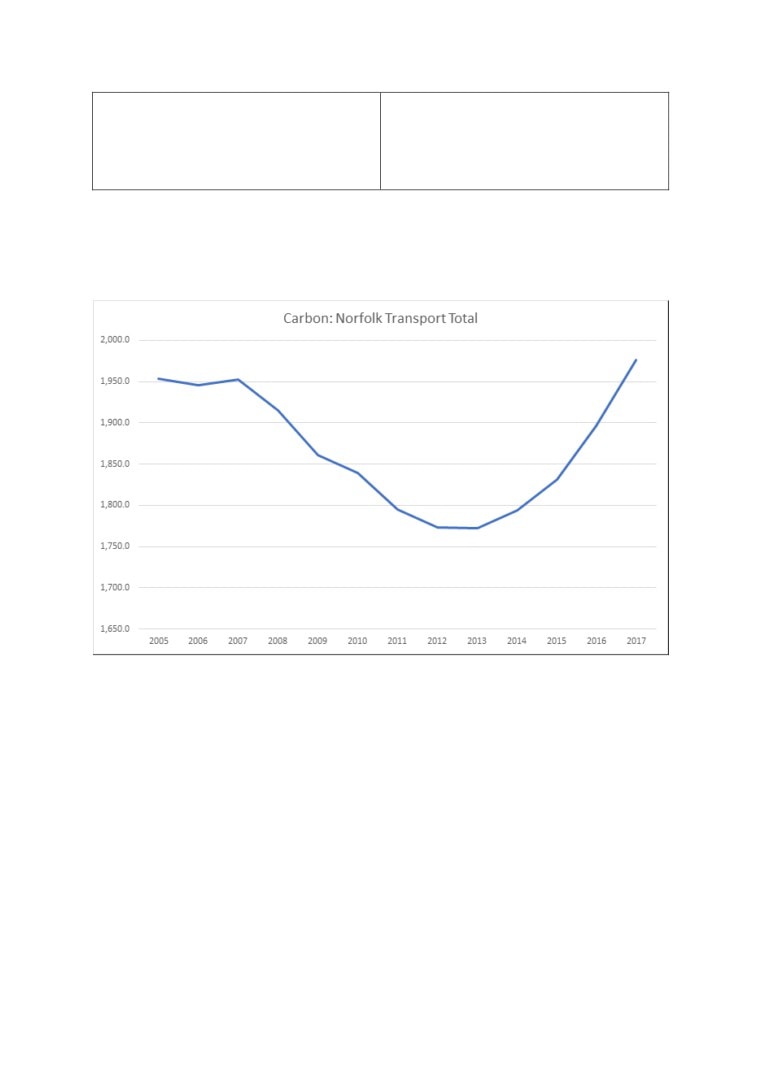New Anglia Transport Board
Agile to Change
Agenda
9.30-11.00am, Monday 30th November 2020 - Virtual Teams
9.30
1.
Welcome and introductions
Chair
9.30
2.
Minutes and matters arising
Chair
9.35
3.
Brexit and Covid intelligence
James Allen
• Impact
• Trends
9.50
4.
Connected Places Catapult New Mobility
Steve Turner
Technologies
10.20
5.
New Anglia LEP Clean Growth Taskforce
Laura Waters
• Purpose
• Governance - group mapping and gap analysis
• How can the Board support the clean growth initiative?
10.45
6.
Transport East update
Andrew
• Strategy development progress
Summers
• Forum
10.55
7.
Any other business
All
• Forward Plan and items for next meeting
• Date of next meeting - 15th March 9.30-11 Teams meeting
Officer Contact
If you have any questions about matters contained on this agenda, please get in touch with:
Laura Waters
07384 258662
New Anglia Transport Board
Connecting the East, Accessing the World
Meeting Note
9.30-11.00am, Tuesday 25th August 2020 - Virtual Teams meeting
Board attendance:
Alan Kirkdale
Highways England
Andrew Summers
Transport East
Andy Walker
Suffolk Chamber of Commerce
Carolyn Barnes
East Suffolk
Chris Soule
CLA
David Cumming
Norfolk County Council
Doug Field
New Anglia LEP
Hayley Mace
New Anglia LEP
James Bradley
Network Rail
Jonathan Cage
Norfolk Chamber of Commerce
Jonathan Denby
Greater Anglia
Kerry Allen
Suffolk County Council
Laura Waters
New Anglia LEP
Cllr Martin Wilby
Norfolk County representative
Nova Fairbank
Norfolk Chamber of Commerce
Patrick Ladbury
GT Railway
Paul Ager
Associated British Ports
Paul Davey
Hutchison Ports
Paul Martin
First Buses
Cllr Phil Smart
Suffolk district representative
Richard Perkins
Suffolk Chamber of Commerce
Suzanne Buck
Suffolk County Council
Apologies:
ABP
Andrew Harston
Andrew Mower
FSB
Cllr Andrew Reid
Suffolk County representative
Caroline Parish
First Buses
Karen Chapman
Suffolk Growth Programme
Jonathan Rudd
New Anglia LEP
2.
Minutes and matters arising
The previous minutes were accepted as a true record and all matters covered in the agenda.
The LEP business resilience and recovery fund scheme of £3m has been launched with 47 awards to date. The 47
awards total £1.8m creating 33 full time positions and protecting 1,200 jobs. Demonstrates the LEPs role and the
importance of working together with partners to support businesses.
3.
New Anglia LEP Recovery Plan
LW presented paper on the New Anglia LEP recovery plan work, updating that the restart plan has been published
and is available online with an accompanying evidence base document. The restart plan is focussed on the short-term
actions required for the next six months, agile and evolving as the full impacts of lockdown become clear and has
been developed by a range of partners. The restart plan was published in June and in the autumn, this plan will be
followed by our Renew Plan - a longer-term plan for jobs and sustainable growth which will also serve to support the
Government national recovery plan.
The renew plan looks to a longer-term horizon of 3-5 years and will include activities to rebuild the economy which
builds on the Economic Strategy and Local Industrial Strategy and responds to long term changes brought about by
the pandemic. The next agenda item seeks view on the strategic transport connections the renew plan should be
considering.
It was asked if any of the projects put forward to the Governments recent Getting Building Fund were for transport?
Given the criteria that projects had to be delivered within 18 months this meant transport projects were not put forward
to this fund as they take longer than this time period to deliver. The list of projects to be delivered through this fund
There has been increased intervention in major highway schemes, would DfT be able to set out what the level of
intervention has been across Norfolk and Suffolk?
Action: LW to follow up with DfT
At the July Transport East Forum, the themes endorsed for the transport strategy complement those set out in the
paper and the Transport East and New Anglia LEP priorities are in alignment.
Highways England strategy has been published and schemes in this region are going through statutory processes.
There are increased amounts of funding for maintenance with £800m available for the next five years meaning there
will be a lot of activity on the network.
4.
Strategic Connections
LW presented paper outlining the strategic transport connections identified in the Norfolk and Suffolk Economic
Strategy (NSES), Local Industrial Strategy (LIS) and Integrated Transport Strategy (ITS) and the measures included in
the recently published Covid-19 Economic Recovery Restart Plan. The Board was asked to consider opportunities to
develop our strategic connections in the context of the “new normal” environment and what actions would help both
the local, regional, and national economy rebuild stronger.
Transport East has similar themes and the connections set out in the paper align with the priorities included in the
draft Transport East Investment and Delivery Plan. This plan sets out the priorities in each of the Local Authority areas
and groups these into corridors. Transport East has also set up active travel and passenger transport subgroups to
challenge how DfT allocate funding to this region, ensuring lobbying/influencing activity is aligned with the LEP so we
do no lose out. Transport East have worked with KPMG on a decarbonisation report and the draft was presented at
the recent forum, this will set out recommendations for the region. The LEP is working closely with Transport East on
active travel and has been attending the subgroup, learning from local authorities about the key issues and providing
support where appropriate.
Action: AS to circulate final version of decarbonisation report to the Board.
The meeting asked what are the priority corridors for the investment and delivery plan? There are 7 corridors identified
across the Transport East region with 4 being in the New Anglia area: A47 from coast to Midlands, King’s Lynn to
Cambridge, East West Rail, A11 and Felixstowe to Nuneaton.
Connecting our Energised Coastal Communities: Midlands - King’s Lynn - Norwich - Great Yarmouth
Connecting the Heart of East Anglia: London - Chelmsford - Colchester - Ipswich - Norwich & Suffolk Coast
Cross-country connectivity: Norwich and Ipswich/Felixstowe - the Midlands and South-West
Connecting Thameside South Essex corridor (south): London - Thurrock - expanding Thameside ports
South Essex corridor (north): London / Chelmsford - Basildon - Southend - Shoeburyness
East-West growth corridor: Manningtree - Basildon - Harlow. Connections to Felixstowe / Harwich and Stansted
UK Innovation Corridor: King’s Lynn - (Cambridge) - Harlow - London
For the East West rail corridor Transport East are working with neighbouring Sub National Transport Bodies to ensure
strategies and lobbying messages are aligning.
We need to ensure the £800m maintenance funding mentioned earlier is planned most effectively to reduce impact on
those who live and work here but also visitors to the region. Highways England are currently assessing the best way
to deliver this programme and will be engaging with the highway authorities.
It was noted that when considering recovery planning, we need to be flexible and proactive to respond to funding
opportunities as they present themselves.
Growth programme is set up to create a pipeline of projects and to also be aware of funding opportunities and being
ready to lobby.
5.
Ely Communication Actions
HM presented slides setting out what the case for Investment at Ely is for Norfolk and Suffolk and proposed actions
that the Transport Board could undertake. The LEP has been working with Transport East and the Ely Taskforce to
identify what the key messages are for the New Anglia area. Ely is in a strategic position and investment there
maximises the capacity of investments made elsewhere on the network. The communication materials need to be
clear so MPs, businesses and stakeholders understand the story for Norfolk and Suffolk but that is part of the wider
strategy to deliver Ely and how it is an enabler of growth for the whole of the UK. The proposed actions can be
undertaken quickly and will be a clear visual representation of our messages and case.
The Board were then asked to feedback on the key messages proposed and suggest any further communications
activities:
•
The 28% rail modal share figure is based on all goods that come into Felixstowe, could this figure be revised
to what percentage of goods that come on to the inland transport network are then transported by rail? This
figure will be higher and strengthens the case around the goods that are currently transported by road but
could be by rail, but the rail network doesn’t have the capacity currently to do this. Message needs to be clear
if you increase capacity at Ely you will increase rail freight, taking vehicles off the road and these vehicles will
be in the north. This project isn’t for the east region but contributes to levelling up agenda and decarbonises
the North.
•
Further statistics could include that currently 50% of goods traffic is to the north and all future growth will be
through Ely. Need strong message that this project is for the benefit of the North, levelling up and
decarbonisation.
•
Investment of public money in relating projects cannot be realised without improvements at Ely.
•
Need to include existing passenger commitments such as improving the Ipswich to Peterborough service, half
hourly Norwich to Cambridge service and further aspirations cannot be achieved without improvements at Ely.
Improved rail services will also contribute to increased modal shift from cars. Could also include the rail
passenger benefits for London.
•
Whilst approvals are likely to be announced in the autumn the speedy delivery of the project needs to be a key
message with current delivery not planned until late 2020’s.
•
Network Rail are very hopeful of a successful announcement from the Treasury shortly and welcome the
strong support from the LEP. The challenge is demonstrating that rail investment is the best value for the
taxpayer. Need to be clear that whilst the Ely Area Enhancement Programme is a significant part of the
solution it is part of a wider group of solutions needed to achieve the full outputs for the area. Network Rail are
currently developing a Strategic Outline Business Case setting out what additional interventions are required
beyond the current proposal and what these will deliver.
•
Do we need to be cautious when widening the programme and should focus on what the project does deliver?
The further interventions are an added dimension to the case, which whilst already significant the additional
interventions and the benefits they will bring will only strengthen this.
•
Need to ensure all these messages are framed in the language that reflects the Government and Chancellors
priorities - job creation and job retention.
•
Communications through the Growth Hub have been short videos, case studies and graphics to share
messages, can we consider presentation methods to engage with key players.
•
Financial costs of this scheme are large, and the benefit side of the equation needs to be significant to
demonstrate the value of the project.
•
3 neighbouring SNTBs sent a joint letter to the treasury lobbying for the investment at Ely so we have partners
that will join us.
•
Need to ensure messages are reaching the right people: Transport ministers, Network Rail, DfT,
Action: HM/LW to produce infographic using feedback above
6.
Transport East update
AS updated that Transport East held their forum in July setting out the increased capabilities and capacity to progress
their work programme. 4 key items were covered: Transport East as a functional body, Investment and Delivery Plan,
Strategy development and communications.
Strategy development: KPMG Decarbonisation report will be finalised shortly. Covid planning is underway with school
travel meeting held with DfT and active travel meeting planned with DfT in September. Consultants are being procured
to develop the wider strategy and engagement with stakeholders likely to begin end of September. Whilst modal shift
and rail are mentioned in the KPMG report the specific opportunity to increase rail capacity and linking to Ely could be
brought out more explicitly in the report. There will be further deep dives into areas of the KPMG report.
Investment and Delivery Plan: existing priorities have been included in the Transport East investment programme;
draft plan was presented to the July forum with feedback being used to inform the finalised version. The final version
will be submitted as part of the comprehensive spending review submission.
DfT sent letter shortly after July forum confirming £425k of funding for this financial year to take the 4 workstreams
listed above forward, Transport East have been invited to a meeting with Baroness Vere alongside the other SNTBs to
set out the vision for the future. Recruitment is also underway for a communications manager and assistant who are
hopefully going to be in place by September.
7.
Any other business
Greater Anglia update: Back to full timetable, with exception of Stansted Express and monitoring capacity. New trains
have created additional capacity meaning extra space for social distancing.
Forward plan next meeting theme - Agile to change: Mobility as a Service, Electric vehicles and Use of data
DF introduced Steve Oliver as the new Transport Board chair and his contact details will be circulated.
Date of next meeting - meeting invite will be circulated shortly.
New Anglia Transport Board
Monday 30th November 2020
Agenda Item 5
New Anglia LEP Clean Growth Taskforce
Author: Laura Waters
Summary
taskforce, whose members will be ambassadors for the ‘UK’s Clean Growth Region’ and
help drive forward and embed the clean growth framework across Norfolk and Suffolk and
beyond. The taskforce will sit below the LEP Board and have representatives from existing
LEP groups and others who would act as clean growth advocates.
The Transport Board needs to consider the actions and activities it is best placed to lead that
supports the clean growth initiative. Members have been asked to provide suggestions for
initiatives, projects or successful case studies we can promote (summarised in table 1),
which will inform the actions for key workstreams for the Board to progress.
Alongside the Taskforce there will be a Norfolk and Suffolk Clean Growth action plan, which
builds on the evidence of the Local Industrial Strategy and the Climate Change Adaption and
Carbon Reduction Scoping Report to outline the areas that Norfolk and Suffolk should
consider with respect to delivering clean growth The existing and future actions of the Board
will help inform the action plan.
Recommendation
The Transport Board is asked to:
• Discuss and consider the suggested actions summarised in Table 1 that the Board can
lead activity on.
• Agree the key workstreams the Board will undertake to support the clean growth
initiative.
Aim
To set out the purpose of the Clean Growth Taskforce, to discuss how the proposed
workstream activities best support this initiative and agree actions for the Transport Board to
take forward.
Purpose of Taskforce
To embed clean growth in the development and delivery of actions and decisions which
deliver the Economic Strategy, and Local Industrial Strategy and Renewal Plan. To drive the
shared ambition for a low carbon and inclusive economic recovery that tackles the
challenges and opportunities of climate change.
Key functions:
•
Further develop the clean growth action plan for Norfolk and Suffolk engaging
relevant partners to securing their buy in to deliver the action plan, through respective
groups and networks.
•
Create a clean growth evidence baseline that identifies and recommends to the LEP
board the areas of focus that the biggest gains can be achieved, and which actions
will be focused on.
•
Promote Norfolk and Suffolk as the UK’s Clean Growth Region helping to raise the
profile of the major contribution the area plays in the UK’s transition to a post carbon
economy, representing the area national, regionally and locally.
•
Ensure clean growth is embedded in the discussion, actions and decision of your
respective group, reporting back to the taskforce as appropriate.
•
Recommend or source appropriate experts to inform certain aspects of the action
plan, convene working groups as appropriate and consult with sector peers as
agreed within the Taskforce under the direction of the Chair.
•
Oversee the development and agree robust ways of measuring and monitoring the
impact of interventions and actions, making recommendations to the LEP board on
any relevant targets or pledges.
•
Annually, bring together the wider network of clean growth champions to share
knowledge and best practice.
The New Anglia LEP strategy team are currently:
• Reviewing the terms of reference for the taskforce to reflect the changes seen since
February 2020
• Assessing the draft action plan
• Mapping the existing partnerships, boards and groups who are already working in
this area to understand their focus/priorities, work programme, delivery actions,
communications activity and governance. This will help us explore opportunities to
work together and inform a gap analysis to identify the areas where the taskforce
could lead.
Transport Board potential workstreams
Clean growth sits at the heart of the New Anglia Local Industrial Strategy with Norfolk and
Suffolk positioned as the UK’s clean growth region. The LIS states our ambition to be:
A globally recognised, technology-driven and inclusive economy which is leading the
transition to a post-carbon economy through sustainable food production and sustainable
energy generation.
Norfolk and Suffolk’s key strengths and assets make it well placed to be at the forefront of
the clean growth revolution
• As the UK’s leading producer of renewable and low carbon energy and a significant
producer of low carbon goods and services.
• As a testbed for innovation in industries such as farming and food production,
transportation and construction which need to reduce their carbon footprint and adapt
to a changing climate.
• As an area with an outstanding natural environment and natural resources which are
particularly vulnerable to climate change but where innovative new mitigation
measures and technologies are being pioneered.
• As an area with a wealth of world class innovation and thinking, and exportable skills.
Along with many award-winning businesses, that are on the leading edge of a low-
carbon future.
The Integrated Transport Strategy identified four priority themes with proposed actions:
Theme
Actions
Connecting the east, accessing the world
Ensuring a resilient Strategic Road Network
Ensuring a better-connected rail network
Challenging perceptions about connectivity
Influencing peak demand requirements
Making whole journey reliability a priority
Encouraging the development of more
regional air services
Regional connectivity and priority places
Deliver a reliable Major Road Network
Make public transport the ‘go to’ option
Facilitate better connectivity
Ensure the success of our Enterprise
Zones, Food Enterprise Zones and key
sectors
Improving public realm
Joined up cycling and walking networks
Develop and promote local freight centres
Agile to change
Complete superfast broadband coverage
and the delivery of ultra-fast broadband
Ensure the delivery of 5G technology
Promote the East as being ‘open’ to
innovative new technologies
Shape collaborative future mobility
Encourage the use of data
Encourage behaviour and cultural change
Local and coastal
Complete superfast broadband coverage
and the delivery of ultra-fast broadband
Ensure the delivery of 5G technology
Prioritising local road improvement
schemes
Cost-effective, on-demand public transport
services
Support community rail partnerships
Encourage walking and cycling
The graph below illustrates that in Norfolk total carbon emissions are rising and 38% of
carbon emissions in Norfolk and Suffolk are from the transport sector, in 2005 this proportion
was only 29%. While transport emissions have reduced over time, other sectors have
observed greater reductions hence the proportion of emissions from transport has increased.
Given the significant contribution the transport sector plays in emissions it is critical that we
consider what actions the Board can undertake that can reduce its contribution over time.
Table 1: Proposed action suggestions by Members
Title
Action
Timescale
Clean Growth Outcomes
Covid Recovery Outcomes
Electrification of
Publicly respond to the
10 years for
Post diesel traction options and
Creates jobs, increases
the railways in
Network Rail Traction
electrification but
identifies electrification as the
business confidence to invest
East Anglia
Decarbonisation Network
proposed actions before
core option with hydrogen and
in the region, and consistent
Study and call for early
next board?
battery power. Felixstowe to
with 'build back better'
progress in East Anglia.
Nuneaton is listed as one of the
objectives
obvious examples where
electrification is justified.
Zero Carbon
Set the goal to halve
Set the ZCC goal
Save 5 million tons of CO2
Save the local economy and
Commuting by
commuting emissions by
November 2020 -
individuals £10bn
Save the local economy and
2040
2030 and to get to zero
propose a 5% reduction
individuals £10bn
Help avoid gridlock as city
by 2040.
per year every year to hit
centre offices reopen and then
Zero carbon commuting
Invest in understanding
transform them into livable
in New Anglia LEP by
the current commuting
cities.
2040.
travel patterns and
emissions.
Gather high level data
November 2020 -
Devise a strategy by
February 2021
March 2021 to achieve
the goals.
Publish the high-level
strategy April 2021.
Support A47
Support communications
January to November
NCC has written to DfT asking
A47 supports clean growth, in
Alliance
program raising
2021
that we work with them on the
the form of supporting offshore
awareness and support
long-term role of the A47, and
energy activities from Gt
for the A47 Alliance and
how it can fulfil its function in the
Yarmouth and Lowestoft.
context of amongst other things
the need to improve the
carbon reduction, which could
A47.
then be used as a model for
other major roads across the
area.
New Train roll
Publish case study on
November to December
Supports the shift to rail
Raises profile of benefits rail for
out case study
the successful roll out of
2020
Promotes the improved
travelling and attracts
new trains
transport connectivity
customers to use rail.
Norfolk and
Board contribute to living
November to December
Challenges perceptions of
Improving perceptions of what
Suffolk unlimited
in Norfolk webpage
2020
connectivity to the region and
it is like to live, work and visit
branding
focusing on connectivity
can raise profile of transport
the region to help attract
projects.
businesses, workers and
visitors to the region.
New Anglia Transport Board
Monday 30th November
Agenda Item 7
Transport Board Forward Plan 2021
Author: Laura Waters
Summary
This paper seeks the Board’s input on the 2021 Forward Plan for the Transport Board with the view
of successfully delivering the Integrated Transport Strategy and aligning with the core themes of the
Transport East Investment and Delivery plan.
Recommendation
The Board:
• offers suggested input to the Transport Board Forward Plan 2021
Background
The Integrated Transport Strategy, adopted by the LEP Board in May 2018 has the following themes:
• Connecting the East, Accessing the World: Quicker, more reliable, and resilient strategic
connections to boost our contribution to UK plc., encouraging improved perceptions, economic
participation and inward investment for our key sectors and competitive clusters.
• Agile to Change: Embracing new technologies and digital connectivity to enable remote access
to services and opportunities to facilitate Mobility as a Service (MaaS).
• Regional Connectivity and Our Priority Places: Keeping people and products moving in and
around our growing Priority Places and Enterprise Zones through new investment,
placemaking, maintenance and an integrated public transport network with opportunities for
walking and cycling.
• Local and Coastal: Innovative on-demand transport solutions and improvements to facilitate local
sustainable growth, walking and cycling, recognising local distinctiveness, and offering access to
services and opportunities through digital means.
Appendix A outlines a draft forward plan for the Board’s input. The Board are asked to consider what
items it would like to consider during the next year and agree the forward plan for 2021.
Link to the Integrated Transport Strategy and Transport East
Outlined above and in Appendix A.
Recommendation
The Board:
• offers suggested input and agree to the Transport Board Forward Plan 2021.
Appendix A
Appendix A - Transport Board Forward Plan
New Anglia Transport Board Forward Plan
Date
Venue and Theme
Forward Looking
Transport East Core Themes
February 2021
Virtual meeting
•
Boosting accessibility by sustainable modes
•
Energising coastal communities
•
Release network pinch-points
•
Supporting a year-round tourist industry
Local and Coastal
•
Utilising data for public transport
•
Potential unlocked through transport
•
Maritime Cluster development
investment
•
Reliable A47, A12 and A14 corridors
•
Transport East update
June 2021
Virtual meeting -TBC
•
Deliver a reliable Major Road Network
•
Multi-centred growth
•
Integrated ticketing/public transport
•
Creating links between our high growth
Regional Connectivity and Our
•
Better connect Enterprise Zones, Food
clusters
Priority Places
Enterprise Zones, and key sectors
•
Better connected and mobile workforce
•
Develop and promote local freight centres
•
Supporting new settlements
•
Transport East update
•
Improved public spaces and access to town
centres
August 2021
Virtual meeting -TBC
•
Ports and airports
•
Global gateways, connecting the country to
•
RIS beyond 2025
world markets
Connecting the East,
•
Rail
•
Better connected ports and airports
Accessing the World
•
BREXIT
•
Raising our profile as a place of rapid regional
•
Transport East update
economic growth
November 2021
Virtual meeting -TBC
•
Mobility as a Service
•
Resilient and low carbon transport network
•
Electric vehicles
•
Early adoption of emerging technologies
Agile to Change
•
Use of data
•
Expansion of infrastructure to support the
•
Transport East update
growth of EVs












